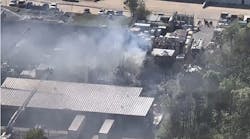Responding to tightening budgets, the Jacksonville Fire and Rescue Department is considering plans to combine some fire suppression and rescue operations in a way that could make rescue more efficient but might slightly slow fire response times.
The move, focused on outlying areas, is opposed by the firefighters' union, which says it will decrease both public safety and firefighter safety.
The new approach would add ambulances to some fire stations that may now only have fire apparatus, with personnel jumping on whichever equipment was needed depending on the type of call. About a third of stations don't have rescue units in them now: When calls come into those stations, engines with life-support equipment respond immediately, with ambulances arriving later.
Whether working on medical rescue or an engine crew, all of Jacksonville's firefighters are either paramedics or emergency medical technicians.
The change, Fire Chief Marty Senterfitt said, is because medical calls far outweigh fire calls. In the past year, department personnel responded to about 119,500 calls, with 85,000 of them for medical rescue. Of the remaining calls, he said, 800 were for structure fires and only 300 of those were serious.
"When I look at the critical life-or-death decisions, you can see why I put the emphasis on rescue," he said. "I can't keep building this department with a focus on fires."
Such an approach, known as cross-manning, has been done in other cities, said Ken Willette of the National Fire Protection Association, with the decision to do so relying on a department's decision as to how best meet its service goals. For it to work, he said, a city must crunch the numbers to see where gaps might occur -- if, for example, the crew dedicated to an engine is down a person because the firefighter is out with the ambulance.
"If a fire engine is short-staffed 50 percent of the time, for example, how do you compensate for that?" he said.
Such shortfalls would be rare, said Senterfitt, who says using staff who previously just rode engines to also ride ambulances is more efficient for Jacksonville taxpayers. The city needs all of its firefighters, he said, but they don't all need to be ready to respond to fires at any one time.
Both types of responders show up to medical calls, but some now come on engines -- which can't transport patients -- and others on ambulances, which can.
On average, Senterfitt said, a fire engine typically arrives first to a medical call, getting to the scene in 3 1/2 minutes. A second engine might arrive 30 seconds later, with an ambulance then on scene four minutes after that.
The change would have the responders show up first with an engine and an ambulance, putting both vehicle types on scene in about four minutes -- halving the ambulance response time.
"You're going to protect and save far more people," Senterfitt said.
But that just means patients will get to the hospital quicker, not that they'll get faster treatment at the scene, said Jacksonville Association of Firefighters President Randy Wyse. The engine that shows up first carries paramedics and emergency medical technicians and has almost the same life-saving equipment as the ambulance.
It can't carry patients away, however, which is the job of the ambulance.
If everyone is on ambulances, though, more firefighters will be stuck waiting at hospitals -- which can take 45 minutes or longer -- and not be available to respond to fires or other calls, Wyse said.
The changes are likely to be made first in an area like Black Hammock Island, at the edge of the county. The fire station serving the 1,000 or so people living there is staffed with an engine and four firefighters who Senterfitt said go on a run only once every six days.
The closest ambulance, he said, is 19 minutes away.
If a medical call is made, the firefighters respond, but they can't take the patient to the hospital.
"If you had an ambulance sitting in the station and something like a snakebite was brought in, you could immediately go on route to the hospital," Senterfitt said. "There are types of calls where transport time is critical."
What happens if a structure fire broke out when the crew was off responding to a medical call? "You can 'what if' yourself to death in this business," Senteriftt said, adding that the island has only one or two structure fires a year.
But even if there isn't a fire at the same time, Wyse said, the proposed change would mean fewer people responding to the medical emergency. Now, four firefighters would show up on the engine, with two rescue personnel in the ambulance. The new system would have the four firefighters show up, but the rescue station wouldn't send anyone, since an ambulance would already be there to do transport.
Not surprisingly, larger crews tend to get more done faster, according to a national Firefighter Safety and Deployment study.
"At some point you start to run out of hands," Wyse said.
The situation becomes more complicated when specific jobs are brought into the mix, he said. Ambulances, for example, are required to have a paramedic on board, not just an emergency medical technician. If the lone paramedic at a station goes to the hospital with the ambulance, problems can arise.
For now the union and administration are planning to kick off talks, with both sides agreeing to a discussion about how the idea will affect jobs.
The city is also moving ahead with buying more ambulances -- a move expected to save money on its own as the department switches to a vehicle based on heavy-duty pickup trucks, and one supported by the union. Previously, the city bought bigger units that were more expensive to buy, repair and operate.
Copyright 2012 - The Florida Times-Union, Jacksonville
McClatchy-Tribune News Service





